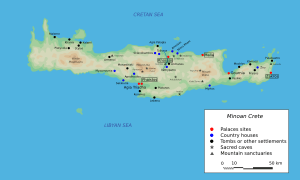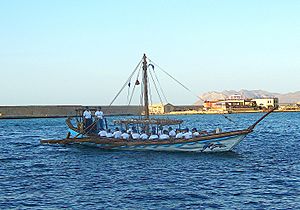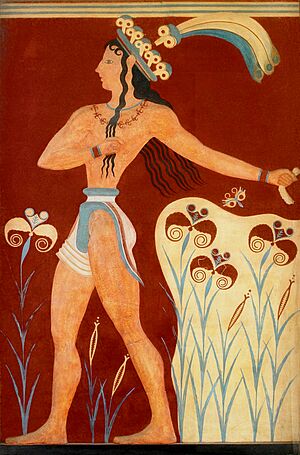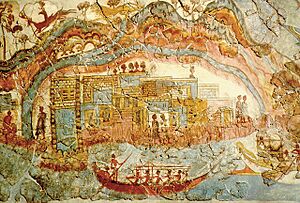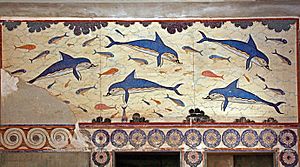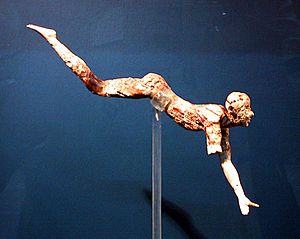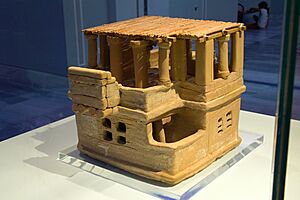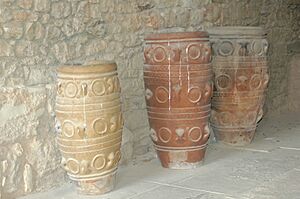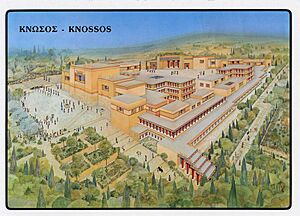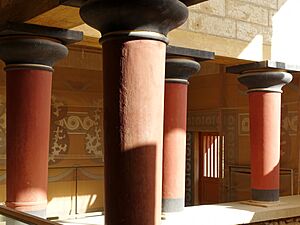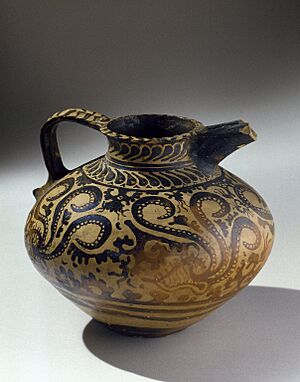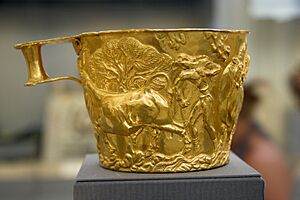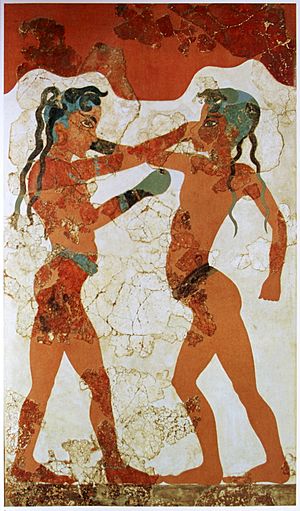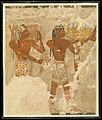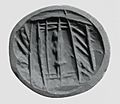Minoan civilization facts for kids
The Minoan civilization was an ancient culture that lived on the island of Crete. It started during the Bronze Age, between 3000 and 2700 BC. This amazing civilization lasted until about 1450 BC. The Minoans were famous for their sea trading and their well-planned cities.
The Minoans were also great farmers. They mainly grew olives and grapes. Their religion mostly involved worshipping goddesses. Later, the Minoan civilization was taken over by the Mycenaean culture.
The people of Crete built grand palaces. These palaces were not just homes for kings. They were also government centers, storage areas, and shops. Most palaces were very large. They might have gotten money for these buildings from working with the Egyptians. Royal palaces were very special. They had toilets, baths, and even running water for everyone. The king and queen's areas were very fancy. A big fire ended this grand building period, which lasted from 2000 BC to 1450 BC.
Contents
Minoan History Timeline
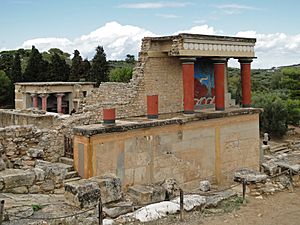
Archaeologists use different ways to understand the Minoan timeline. One way looks at how their pottery styles changed over time. Another way looks at how their "palaces" developed.
The earliest signs of modern humans on Crete date back about 10,000 to 12,000 years ago. The first farming communities appeared around 7000 BC. These early people lived in open villages. They used the fertile Mesara Plain for farming.
Early Minoan Period
The Early Bronze Age on Crete (3500 to 2100 BC) showed great promise. The Bronze Age began around 3200 BC. During this time, different places on the island became important for trade and crafts. This allowed powerful families to become leaders. It is thought that these leaders eventually became kings. This set the stage for building the large palaces.
Middle Minoan Period
Around 1700 BC, something big happened on Crete. It was probably a huge earthquake. It might also have been an invasion from Anatolia. The main palaces at Knossos, Phaistos, Malia, and Kato Zakros were all destroyed.
After this, the population grew again. The palaces were rebuilt even bigger than before. New towns also appeared across the island. This time, from the 17th to 16th centuries BC, was the peak of Minoan civilization. Minoan influence also spread to the Greek mainland.
Late Minoan Period
Another natural disaster happened around 1600 BC. This was likely a huge eruption of the Thera volcano. The Minoans rebuilt their palaces again. But this time, they changed how the palaces were used.
Around 1450 BC, Minoan culture faced another big challenge. This was probably another earthquake. Some important palaces, like those in Malia and Phaistos, were destroyed. The palace in Knossos seemed to survive mostly intact. This allowed its rulers to control much of Crete. However, the Mycenaean Greeks eventually took over.
After a short recovery, most Cretan cities and palaces declined by the 13th century BC. Knossos remained a center until 1200 BC. The very last Minoan site was a mountain refuge called Karfi. People lived there almost until the Iron Age.
Foreign Connections
Minoan culture had a big impact on the Greek mainland. Minoan goods were found in the graves of Mycenae. This shows that Minoan ideas were important there.
The Minoans also had strong ties with Egypt. Minoan pottery has been found in Egyptian cities. The Minoans brought items like papyrus from Egypt. They also got ideas for their buildings and art from Egypt. Egyptian hieroglyphs might have even inspired Minoan writing systems. These include Linear A and Linear B.
Around 1420–1375 BC, the Mycenaeans took over Minoan palace sites. They learned from the Minoans. They used the Minoan writing system (Linear A) for their own language. This language was written in Linear B. The Mycenaeans adopted Minoan culture, religion, and art. They continued the Minoan way of trade and government.
Minoan Geography
Crete is a mountainous island with many natural harbors. There are signs of earthquake damage at many Minoan sites. This shows that the island's land has moved a lot over time.
According to ancient stories, Crete had 90 cities. The island was likely divided into at least eight political areas. This was during the height of the Minoan period. Most Minoan sites are in central and eastern Crete. There are only a few in the western part.
There were four main palaces on the island: Knossos, Phaistos, Malia, and Kato Zakros. Knossos probably ruled the north. Phaistos ruled the south. Malia ruled the central-eastern area. Kato Zakros ruled the eastern tip. Smaller palaces have been found in other places.
Important Minoan Settlements
- Knossos – This was the largest ancient site on Crete. Its population was huge. It grew from 1,300 people in 2500 BC to possibly 100,000 in 1600 BC.
- Phaistos – This was the second-largest palace.
- Malia – An important palace that shows us about the early palace period.
- Kato Zakros – A palace right by the sea in eastern Crete.
- Galatas – Confirmed as a palace site in the 1990s.
- Agia Triada – An administrative center near Phaistos. It had the most Linear A tablets.
- Gournia – A town site.
- Pyrgos – An early Minoan site in southern Crete.
- Vasiliki – An early eastern Minoan site known for its unique pottery.
- Fournou Korfi – A southern site.
- Pseira – An island town with special religious sites.
- Mount Juktas – The most important Minoan mountain sanctuary. It was linked to Knossos.
- Arkalochori – Where the famous Arkalochori Axe was found.
- Karfi – A refuge site, one of the last Minoan places.
- Akrotiri – A settlement on the island of Santorini. It was near the Thera Eruption site.
- Zominthos – A mountain city in the northern foothills of Mount Ida.
Minoans Beyond Crete
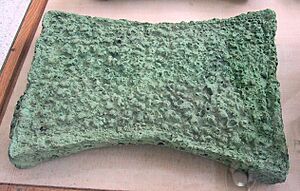
The Minoans were skilled traders. They had connections with many places. These included Egypt's Old Kingdom, Cyprus (which had copper), Canaan, and Anatolia.
In 2009, Minoan-style frescoes were found in a palace in Tel Kabri, Israel. This shows that Minoan culture had a strong influence on the Canaanite city-state. These are the only Minoan artifacts found in Israel.
Minoan styles also influenced Helladic Greece. Minoan settlements were found on Cythera. This island is near the Greek mainland. The Minoans influenced it from 2500 BC until the Mycenaeans took over. This was the earliest Minoan settlement outside Crete.
The Cyclades islands were also part of the Minoan cultural area. Islands closer to Crete, like Karpathos, also had Minoan colonies. These were abandoned around 1500 BC. But Karpathos recovered and kept its Minoan culture. There was also a Minoan colony at Ialysos on Rhodes.
Paintings from the 15th century BC in Thebes, Egypt show people who look Minoan. They are bringing gifts. These people are described as coming from "keftiu." This means "islands in the middle of the sea." This likely refers to Crete.
Some places on Crete show that the Minoans looked outwards. The site of Kato Zakros is right by the sea. It had many workshops and rich materials. This suggests it was a major trading hub. Minoan art also shows many scenes of the sea. This includes the "Flotilla" fresco at Akrotiri.
Farming and Food

The Minoans raised cattle, sheep, pigs, and goats. They grew wheat, barley, and chickpeas. They also grew grapes, figs, and olives. They even grew poppies for their seeds. The Minoans also kept bees.
Many vegetables grew wild on Crete. These included lettuce, celery, and carrots. Pear, quince, and olive trees were also native. They brought date palm trees and cats from Egypt. The Minoans got pomegranates from the Near East. But they did not have lemons or oranges.
They might have used "polyculture." This means growing many different crops together. This kept the soil healthy. It also protected them if one crop failed. Olive oil was very important in their cooking. It was like butter in other cultures. Making wine from grapes was also a big part of their economy. Wine was used for trade and for drinking. Farmers used wooden plows pulled by donkeys or oxen.
Seafood was also a key part of their diet. They ate many kinds of shellfish. Their art shows fish and sea animals. This means they valued fish. However, scholars believe grains, olives, and animal products were more important. Fishing was a major activity. But we don't know how they organized it. They built terraces and dams to increase farming.
Cretan food also included wild game. They ate wild deer and wild boar. These animals are now extinct on Crete.
Not all plants were just for food. Art shows scenes of lily-gathering in beautiful green areas. The "Sacred Grove" fresco at Knossos shows women among trees. Some think it was a harvest festival. Art also shows farming scenes. The "Harvester Vase" shows 27 men carrying hoes. This shows how important farming was in their art.
Palace storage areas show they were centers for food. Jars and vessels were found. This means palaces might have given out farm products. Larger sites like Knossos had special workshops. The Minoan palace system probably grew because of farming. Extra food could support people who worked as administrators, craftsmen, and religious leaders. The palaces had many rooms. This suggests they could house many people who did not do manual labor.
Farming Tools
Early tools were made of wood or bone. They were tied to handles with leather. During the Bronze Age, tools were made of bronze. Minoans improved tools by making oval holes. This stopped the tool head from spinning on the handle. Tools included double adzes, axes, sickles, and chisels.
Minoan Society and Culture
The Minoans were mainly a trading people. They traded overseas. After 1700 BC, their culture was very organized. Minoan goods show they traded with mainland Greece (especially Mycenae), Cyprus, Syria, Anatolia, Egypt, Mesopotamia, and even as far west as the Iberian peninsula.
Minoan religion seemed to focus on female gods. Women were often religious leaders. While we don't think it was a true matriarchy, women had important roles. Their gods included a mother goddess of fertility. There was also a goddess of animals. Female protectors of cities, homes, and harvests were also important. They were often shown with serpents, birds, or poppies.
Government
We don't know exactly how the Minoans governed. Their language has not been fully understood. But the palaces and throne rooms suggest they had a system with leaders.
Saffron Trade
A famous fresco from Santorini shows people gathering saffron. Saffron comes from a special crocus flower. The Minoans traded saffron. It was a big industry for them. It was used for dye. Some archaeologists think it had religious meaning. Saffron trade was as valuable as frankincense or black pepper.
Fashion
Minoan men wore loincloths and kilts. Women wore robes with short sleeves. They also wore layered, ruffled skirts. Women could wear a strapless, fitted top. Their clothes often had balanced, geometric patterns.
Language and Writing
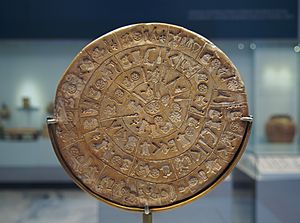
Several writing systems from the Minoan period have been found. Most of them are still a mystery.
The most famous is Linear A. It was used between 2500 BC and 1450 BC. Linear A is the ancestor of Linear B. Linear B is the earliest known form of Greek. People have tried to translate Linear A. But we still don't understand it. The language of Linear A is called "Minoan." If we use Linear B sounds for Linear A, the words don't make sense. This means Minoan is not like any other known language.
Before Linear A, there were Cretan hieroglyphs. We don't know if they are the Minoan language. They might be linked to Egyptian or Mesopotamian writing. They were used at the same time as Linear A for a while. They disappeared around 17th century BC.
The Phaistos Disc has a unique picture writing. Its origin is debated. But many now believe it came from Crete. Since it's the only one of its kind, its writing is still a secret.
Later, some inscriptions from the 7th and 6th centuries BC were found. They were in an old Greek alphabet. But they wrote a non-Greek language called "Eteocretan" (meaning "True Cretan"). We don't know much about it. It's unclear if Eteocretan is related to the Minoan language.
Religion
The Minoans seemed to worship a Great Goddess. This once made people think their society was matriarchal. But now we know this wasn't true. The Minoan gods included many deities. A young, spear-wielding male god was also important. Some scholars think the Minoan Goddess was a female sun god.
Symbols
Minoan altars with horns on top are called Horns of Consecration. They are seen in art and found in places like Cyprus. Important Minoan symbols include the bull (and its horns), the labrys (double-headed axe), the pillar, the serpent, the sun-disc, and the tree.
Some scholars think these symbols were about bees, not religion. A major festival was bull-leaping. This is shown in frescoes at Knossos.
Burial Customs
We learn a lot about the Minoans from their burial sites. By the end of the Second Palace Period, there were two main types of tombs. These were round tombs (tholoi) in southern Crete. And house tombs in the north and east. Most Minoans were buried, not cremated. People were usually buried alone. One exception was the Chrysolakkos complex in Malia. This might have been for burial rituals or a family crypt.
Evidence of possible human sacrifice has been found at three sites. These are Anemospilia, Fournou Korifi, and a building in Knossos.
Architecture
Minoan cities had roads paved with stone blocks. Streets had drains. Upper-class homes had water and sewage systems. These used clay pipes.
Minoan buildings often had flat, tiled roofs. They had plaster, wood, or flagstone floors. They were usually two or three stories high. Lower walls were made of stone and rubble. Upper walls were made of mudbrick. Wooden beams held up the roofs.
Villas and palaces used different building materials. These included sandstone, gypsum, and limestone. Some palaces used finely cut stone blocks. Others used rough, large blocks.
Palaces
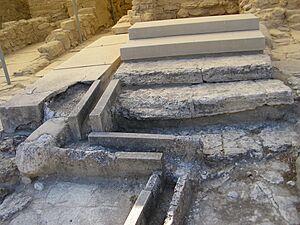
Palaces (anaktora) are the most famous Minoan buildings. They were huge buildings used for government. Archaeologists found large archives there. Each palace is unique. But they all share common features. Palaces often had many stories. They had indoor and outdoor staircases, light wells, huge columns, storage areas, and courtyards.
The first palaces were built around 2000 BC. The main older palaces are Knossos, Malia, and Phaistos. These palaces were centers of government, offices, shrines, workshops, and storage.
Middle Minoan palaces were built to fit their surroundings. Phaistos aligned with Mount Ida. Knossos aligned with Mount Juktas. Both were on a north-south line. This might have been for religious reasons. Many peak sanctuaries (places for public rituals) have been found. These sites had clay figures and signs of animal sacrifice.
Later palaces had many stories. Their western fronts were made of sandstone. Knossos is the best example. Other features included storage areas and a western courtyard. The Palace of Knossos was the largest Minoan palace. It was about 150 meters across. It covered about 20,000 square meters. It might have had a thousand rooms. The palace is linked to the myth of The Bull of Minos. It was said to have a labyrinth.
The palace of Knossos had foundations that matched its walls. This shaped the rooms, stairs, and halls. The palace was built around a central court. Pillars and a stone-paved northern entrance gave it a unique look. Rooms and hallways surrounded the court. Some were stacked on top of each other. They were connected by ramps and stairs. On the east side, a grand staircase led to royal areas. On the west, the throne room was found. It was a simple room with frescoes on the walls.
Plumbing
The Minoans built many waterways. These helped their growing population. They had two main jobs. First, they supplied and shared water. Second, they moved sewage and stormwater away. Minoan waste management was amazing. They used wells, cisterns, and aqueducts for water. Flat roofs and open courtyards collected rainwater. They even had water filters. One device was a porous clay pipe. Water flowed through it until it was clean.
Columns
Minoan columns are very special. They are wider at the top than the bottom. This is opposite to most Greek columns. They were made of wood, not stone. They were usually painted red. They sat on a simple stone base. On top, they had a round, pillow-like capital.
Villas
Many "villas" have been found on Crete. These buildings were like smaller palaces. They had a noticeable western front, storage, and a three-part Minoan Hall. This might mean they had a similar role to palaces. Or they were built to look like palaces. This suggests their owners knew about palace culture. The villas were often richly decorated. The frescoes at Haghia Triadha Villa A show this.
Minoan Art
The biggest collection of Minoan art is in the museum at Heraklion. This is near Knossos. Minoan art helps archaeologists understand their culture. Especially the different styles of pottery.
Wood and textiles have disappeared over time. So, the best examples of Minoan art are their pottery. Also, palace architecture with frescos (including landscapes). And stone carvings and detailed seal stones.
Frescoes were the main art form. They show many people. Men's skin was reddish-brown. Women's skin was white. Many frescoes from Knossos and Santorini still exist. Unlike Egyptian frescoes, Crete had true frescoes. The most famous is the bull-leaping fresco.
Pottery
Many types of pottery were made in Crete. Early Minoan pottery had patterns of spirals, triangles, and curved lines. Middle Minoan pottery had realistic designs. These included fish, squid, birds, and lilies. In the Late Minoan period, flowers and animals were still common. But there was more variety.
The "marine style" pottery is famous. It has the whole pot covered with sea creatures. These include octopus, fish, and dolphins. They are set against rocks and seaweed.
Jewelry
The Minoans made beautiful metalwork. They used imported gold and copper. Frescoes show bead necklaces, bracelets, and hair ornaments. Many double-axe pins (labrys pins) have been found. The Minoans were skilled at faience and granulation. A gold bee pendant shows this. Minoan metalworkers could bond gold without burning it. This needed very precise heat.
Metal Vessels
Metal vessels were made in Crete from about 2500 BC. The earliest ones were probably made of precious metals. Later, they used arsenical bronze and then tin bronze. Most precious metal vessels were cups. But bronze vessels included cauldrons, pans, and bowls.
Minoan metalworking influenced the Mycenaean culture on mainland Greece. Many precious metal vessels found in Greece look Minoan. They were either imported from Crete. Or made by Minoan artists working for Mycenaeans. Or by Mycenaean artists trained by Minoans.
Warfare and the "Minoan Peace"
Some scholars, like Arthur Evans, believed in a "Minoan peace." This meant there was little fighting within Minoan Crete. At least until the Mycenaean period. But it's hard to be sure from the evidence. This idea has been questioned.
No evidence of a Minoan army has been found. And few signs of war appear in Minoan art.
On mainland Greece, there were few Mycenaean forts at first. But strong forts appeared after Minoan sites were destroyed. Other ancient cultures, like the Egyptians and Hittites, clearly show warfare.
Doubts and Weapons
Even though ruined watchtowers were found, Evans said there was little proof of Minoan forts. But some scholars say many early Minoan sites were built on hilltops or fortified.
Lucia Nixon said we might not have looked for evidence in the right places. So, we might not have a correct idea of Minoans and their ability to avoid war.
Chester Starr pointed out that other ancient cultures, like Shang China and the Maya, had unfortified centers. But they still had border fights. So, a lack of forts doesn't mean Minoans were always peaceful. In 1998, archaeologists discussed this. Evidence of Minoan war was still rare.
Jan Driessen said Minoans often showed "weapons" in their art. But it was in a ritual way. He said fortified centers were for many things. They were also symbols of power.
Stella Chryssoulaki's work on small outposts in eastern Crete suggests a possible defense system. High-quality Minoan swords were found in palaces. One scholar estimated that 95 percent of Minoan "weapons" were not made for fighting. They were more like tools. But tests showed replicas could cut flesh. Middle Minoan "rapiers" almost three feet long have been found.
Regarding Minoan warfare, one archaeologist concluded that weapons and forts might have been more about status and fashion than actual fighting. He suggested that fighting in the early Bronze Age Aegean was either personal and ritualistic (in Crete) or small-scale and economic. Another archaeologist agreed. She said there is no direct proof of war in the prehistoric Aegean.
Minoan Civilization's End
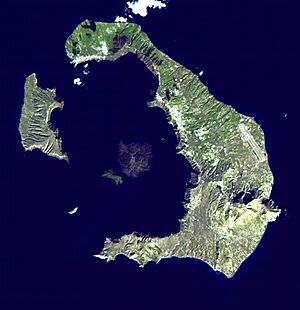
Between 1935 and 1939, a Greek archaeologist suggested the Minoan eruption theory. A huge eruption happened on the island of Thera (now Santorini). This was around 1550 - 1500 BC. Thera is about 100 km from Crete. It was one of the biggest volcanic explosions ever. It threw out a huge amount of material. The eruption destroyed the Minoan town of Akrotiri on Santorini. It was buried in pumice.
This eruption likely affected Minoan culture on Crete. But how much is still debated. Early ideas said volcanic ash from Thera killed plants on eastern Crete. This would have starved people. But later studies found only a small amount of ash fell on Crete.
Archaeological evidence suggests a huge tsunami from the Thera eruption hit Crete's coast. It destroyed many Minoan settlements. The period after the eruption (Late Minoan IIIA) was still wealthy. It had rich tombs and art. But by Late Minoan IIIB, Knossos' wealth declined.
Important remains have been found above the Thera ash layer. This means the eruption did not cause the immediate end of Minoan civilization. The Minoans were a sea power. So the eruption probably caused big economic problems. Whether this was enough to cause their downfall is still discussed.
Mycenaean Greece conquered the Minoans during the Late Minoan II period. Mycenaean weapons were found in graves on Crete soon after the eruption.
Many archaeologists believe the eruption caused a crisis. This made the Minoans weak. So they were easier for the Mycenaeans to conquer. According to Sinclair Hood, invaders likely conquered the Minoans. The Thera eruption helped the civilization fall. But the final end came from conquest.
Evidence shows the island was destroyed by fire. The palace at Knossos was less damaged than other sites. Natural disasters don't pick and choose. So, the uneven destruction was probably caused by invaders. They would have wanted to keep Knossos for themselves. Some authors also think Minoan civilization had too many people for its environment. Evidence at Knossos suggests deforestation in later stages.
Images for kids
-
Detail of Minoan painting, from Akrotiri, the Ship Procession
-
Cretans (Keftiu) bringing gifts to Egypt, in the Tomb of Rekhmire, under Pharaoh Thutmosis III (c. 1479-1425 BC)
-
The (incomplete) "Harvester Vase", soapstone, LM I.
-
Fresco from the temple of the Palace of Knossos, showing Minoan architecture
-
Blade of the "Lion Hunt Dagger", National Archaeological Museum, Athens
See also
 In Spanish: Civilización minoica para niños
In Spanish: Civilización minoica para niños


